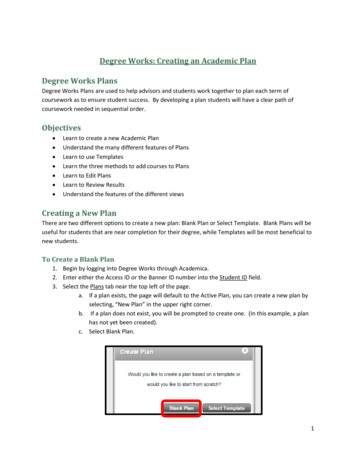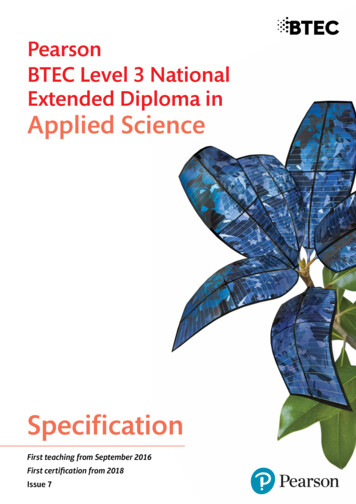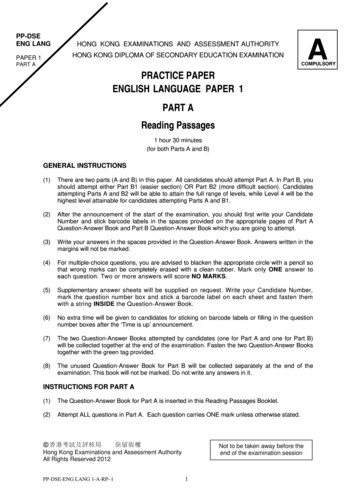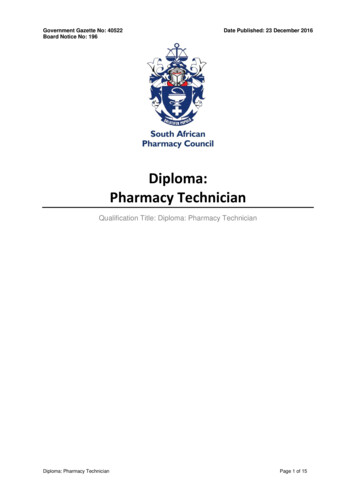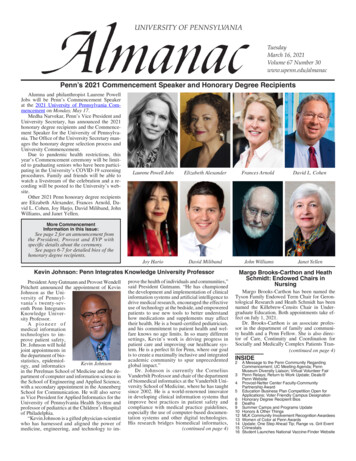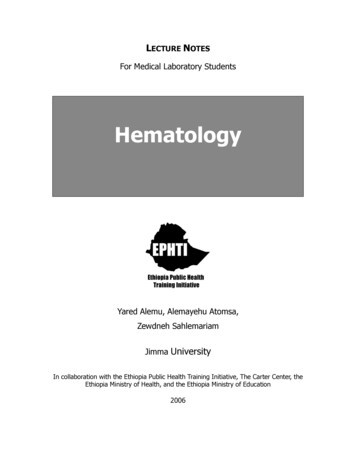
Transcription
LECTURE NOTESFor Medical Laboratory StudentsHematologyYared Alemu, Alemayehu Atomsa,Zewdneh SahlemariamJimma UniversityIn collaboration with the Ethiopia Public Health Training Initiative, The Carter Center, theEthiopia Ministry of Health, and the Ethiopia Ministry of Education2006
Funded under USAID Cooperative Agreement No. 663-A-00-00-0358-00.Produced in collaboration with the Ethiopia Public Health Training Initiative, The CarterCenter, the Ethiopia Ministry of Health, and the Ethiopia Ministry of Education.Important Guidelines for Printing and PhotocopyingLimited permission is granted free of charge to print or photocopy all pages of thispublication for educational, not-for-profit use by health care workers, students or faculty.All copies must retain all author credits and copyright notices included in the originaldocument. Under no circumstances is it permissible to sell or distribute on a commercialbasis, or to claim authorship of, copies of material reproduced from this publication. 2006 by Yared Alemu, Alemayehu Atomsa, Zewdneh SahlemariamAll rights reserved. Except as expressly provided above, no part of this publication maybe reproduced or transmitted in any form or by any means, electronic or mechanical,including photocopying, recording, or by any information storage and retrieval system,without written permission of the author or authors.This material is intended for educational use only by practicing health care workers orstudents and faculty in a health care field.
PREFACEThe lack of sufficient reference materials and uniformityin course syllabi has always been a problem in higherinstitutions in Ethiopia that are engaged in traininghealth professionals including laboratory technologists.Hence, the authors hope that this lecture note would beimmensely useful in solving this existing problem atsignificant level. The lecture note is intended for use bylaboratory technologist both during their training and intheir work places. There are twenty two chapters eachbeginning with specific learning objectives in whichsucceeding by a background of the topic in discussion.There are study questions at the end of each chapter forthe reader to evaluate his understanding of the contents.In addition, important terms are defined in the glossarysection at the end of the text.
ACKNOWLEDGEMENTIt is with sincere gratitude and pleasure that weacknowledge The Carter Center for the collaboration inpreparation of this lecture note.Special thanks are due to Mohammed Awole, SerkadisDebalke, Ibrahim Ali, Misganaw B/sellasie, AbiyeShume, Shewalem Shifa and Simon G/tsadik for theirassistance in reviewing and critiquing this material.For her sustained devotion and extra effort, I express mydeep gratitude and sincere appreciation to ZenayeHailemariam, who has been most supportive withscrupulous attention and dedication in helping methroughout the preparation of this lecture note (Y.A).
Table of ContentsPreface .iAcknowledgement .iiTable of Contents .iiiIntroduction .v1. Blood.12. Blood Collection .423. Anticoagulants .614. Preparation of Blood Smears .675. Staining of Blood Smears .776. Hemocytometry .897. Differential Leucocyte Count.1228. Reticulocyte Count.1369. Hemoglobin.14610. Packed Cell Volume .17611. Red Cell Indices .18812. Erythrocyte Sedimentation Rate .197
13. Osmotic Fragility of the Red Cell .20914. Bone marrow smear examination .21515. Lupus Erythematosus Cell .22616. Red cell Morphology Study .23217. Anemia .24418. Hematological Malignancies .31119. Leucocyte cytochemistry .33920. Hemostasis .35721. Body fluid analysis .43422. Automation in Hematology .466Glossary .477References .567
INTRODUCTIONThe word hematology comes from the Greek haima(means blood) and logos (means discourse); therefore,the study of hematology is the science, or study, ofblood.Hematology encompasses the study of bloodcells and coagulation.Included in its concerns areanalyses of the concentration, structure, and function ofcells in blood; their precursors in the bone marrow;chemical constituents of plasma or serum intimatelylinked with blood cell structure and function; and functionof platelets and proteins involved in blood coagulation.The study of blood has a very long history.Mankindprobably has always been interested in the blood, sinceprimitive man realized that loss of blood, if sufficientlygreat, was associated with death.And in Biblicalreferences, “to shed blood” was a term used in thesense of “to kill”.Before the days of microscopy only the grossappearance of the blood could be studied.Clotted
blood, when viewed in a glass vessel, was seen to formdistinct layers and these layers were perceived toconstitute the substance of the human body. Health anddisease were thought to be the result of proper mixtureor imbalance respectively of these layers.Microscopic examination of the blood by Leeuwenhoekand others in the seventeenth century and subsequentimprovements in their rudimentary apparatus providedthe means whereby theory and dogma would graduallybe replaced by scientific understanding.Currently, with the advancement of technology in thefield, there are automated and molecular biologicaltechniques enable electronic manipulation of cells anddetection of genetic mutations underlying the alteredstructure and function of cells and proteins that result inhematologic disease.
HematologyCHAPTER ONEBLOODLearning ObjectivesAt the end of this chapter, the student shall be able to: Explain the composition of blood Describe the function of blood Describe the formation of blood cells. Explain the regulatory mechanisms in hemopoiesis Indicate the sites of hemopoiesis in infancy,childhood and adulthood.1 Composition blood1
HematologyBlood is a circulating tissue composed of fluid plasmaand cells.It is composed of different kinds of cells(occasionally called corpuscles); these formed elementsof the blood constitute about 45% of whole blood. Theother 55% is blood plasma, a fluid that is the blood'sliquid medium, appearing yellow in color. The normal pHof human arterial blood is approximately 7.40 (normalrange is 7.35-7.45), a weak alkaline solution. Blood isabout 7% of the human body weight, so the averageadult has a blood volume of about 5 liters, of which 2.7-3liters is plasma. The combined surface area of all thered cells in the human body would be roughly 2000times as great as the body's exterior surface.Blood plasmaWhen the formed elements are removed from blood, astraw-colored liquid called plasma is left.Plasma isabout 91.5% water and 8.5% solutes, most of which byweight (7%) are proteins. Some of the proteins inplasma are also found elsewhere in the body, but thoseconfined to blood are called plasma proteins.Theseproteins play a role in maintaining proper blood osmoticpressure, which is important in total body fluid balance.Most plasma proteins are synthesized by the liver,2
Hematologyincluding the albumins (54% of plasma proteins),globulins (38%), and fibrinogen (7%). Other solutes inplasma include waste products, such as urea, uric acid,creatinine, ammonia, and bilirubin; nutrients; vitamins;regulatory substances such as enzymes and hormones;gasses; and electrolytes.Formed elementsThe formed elements of the blood are broadly classifiedas red blood cells (erythrocytes), white blood cells(leucocytes) and platelets (thrombocytes) and theirnumbers remain remarkably constant for each individualin health.I. Red Blood CellsThey are the most numerous cells in the blood.Inadults, they are formed in the in the marrow of the bonesthat form the axial skeleton. Mature red cells are nonnucleated and are shaped like flattened, bilaterallyindented spheres, a shape often referred to as”biconcave disc” with a diameter 7.0-8.0µm andthickness of 1.7-2.4µm. In stained smears, only theflattened surfaces are observed; hence the appearanceis circular with an area of central pallor corresponding to3
Hematologythe indented regions.They are primarily involved in tissue respiration. The redcells contain the pigment hemoglobin which has theability to combine reversibly with 02. In the lungs, thehemoglobin in the red cell combines with 02 andreleases it to the tissues of the body (where oxygentension is low) during its circulation. Carbondioxide, awaste product of metabolism, is then absorbed from thetissues by the red cells and is transported to the lungs tobe exhaled. The red cell normally survives in the bloodstream for approximately 120 days after which time it isremoved by the phagocytic cells of thereticuloendothelial system, broken down and some of itsconstituents re utilized for the formation of new cells.II. White Blood CellsThey are a heterogeneous group of nucleated cells thatare responsible for the body’s defenses and aretransported by the blood to the various tissues wherethey exert their physiologic role, e.g. phagocytosis.WBCs are present in normal blood in smaller numberthan the red blood cells (5.0-10.0 103/µl in adults).Their production is in the bone marrow and lymphoidtissues (lymph nodes, lymph nodules and spleen).4
HematologyThere are five distinct cell types each with acharacteristic morphologic appearance and specificphysiologic role. These are: Polymorphonuclear sophilesMononuclear leucocytesoLymphocytesoMonocytesFig. 1.1 Leucocytes5
HematologyPolymorphonuclear LeucocytesPolymorphonuclear Leucocytes have a single nucleuswith a number of lobes. They Contain small granules intheir cytoplasm, and hence the name granulocytes.There are three types according to their stainingreactions.NeutrophilsTheir size ranges from 10-12µm in diameter. They arecapable of amoeboid movement. There are 2-5 lobes totheir nucleus that stain purple violet. The cytoplasmstains light pink with pinkish dust like granules. Normalrange: 2.0-7.5 x 103/µl. Their number increases in acutebacterial infections.EosinophilsEosinophils have the same size as neutrophils or maybe a bit larger (12-14µm).There are two lobes to theirnucleus in a "spectacle" arrangement.Their nucleusstains a little paler than that of neutrophils. Eosinophilscytoplasm contains many, large, round/oval orange pinkgranules. They are involved in allergic reactions and incombating helminthic infections. Normal range: 40-400/µl. Increase in their number (eosinophilia) is associatedwith allergic reactions and helminthiasis.6
HematologyBasophilsTheir size ranges from 10-12µm in diameter. Basophileshave a kidney shaped nucleus frequently obscured by amass of large deep purple/blue staining granules. Theircytoplasmic granules contain heparin and histamine thatare released at the site of inflammation. Normal range:20-200/µl. Basophilia is rare except in cases of chronicmyeloid leukemia.Mononuclear LeucocytesLymphocytesThere are two varieties: Small LymphocytesTheir size ranges from 7-10µm in diameter. Smalllymphocytes have round, deep-purple stainingnucleus which occupies most of the cell. There isonly a rim of pale blue staining cytoplasm. Theyare the predominant forms found in the blood. Large LymphocytesTheir size ranges from 12-14µm in diameter.7
HematologyLarge lymphocytes have a little paler nucleus thansmall lymphocytes that is usually eccentricallyplaced in the cell. They have more plentifulcytoplasm that stains pale blue and may contain afew reddish granules.The average number oflymphocytes in the peripheral blood is 2500/µl.Lymphocytosis is seen in viral infections especiallyin children.MonocytesMonocytes are the largest white cells measuring14-18µm in diameter.They have a centrally placed,large and ‘horseshoe’ shaped nucleus that stains paleviolet.Their cytoplasm stains pale grayish blue andcontains reddish blue dust-like granules and a few clearvacuoles.They are capable of ingesting bacteria andparticulate matter and act as "scavenger cells" at thesite of infection.Normal range: 700-1500/µl.Monocytosis is seen in bacterial infections.(e.g.tuberculosis) and protozoan infections.III. PlateletsThese are small, non nucleated, round/oval cells/cellfragments that stain pale blue and contain many pinkgranules. Their size ranges 1-4µm in diameter.8They
Hematologyare produced in the bone marrow by fragmentation ofcells called megakaryocytes which are large andmultinucleated cells.Their primary function ispreventing blood loss from hemorrhage. When bloodvessels are injured, platelets rapidly adhere to thedamaged vessel and with one another to form a plateletplug. During this process, the soluble blood coagulationfactors are activated to produce a mesh of insolublefibrin around the clumped platelets. This assists andstrengthens the platelet plug and pro
LECTURE NOTES For Medical Laboratory Students Hematology Yared Alemu, Alemayehu Atomsa, Zewdneh Sahlemariam Jimma University In collaboration with the Ethiopia Public Health Training Initiative, The Carter Center, the


